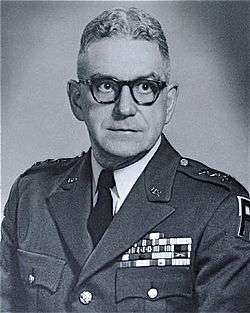Edward J. O'Neill
Edward Joseph O'Neill (March 24, 1902 – January 9, 1979) was a career United States Army officer and battalion combat commander in World War II. He later commanded logistics and support organizations and senior military staff in Europe during the Cold War-era.
Edward J. O'Neill | |
|---|---|
 | |
| Born | March 24, 1902 St. Albans, Vermont |
| Died | January 9, 1979 (aged 76) Arlington, Virginia |
| Buried | |
| Allegiance | United States |
| Service/ | United States Army |
| Years of service | 1924–1962 |
| Rank | Lieutenant General |
| Commands held | First United States Army United States Army Communication Zone, Europe |
| Battles/wars | World War II
|
| Awards | Army Distinguished Service Medal (2) Legion of Merit Bronze Star Medal |
Military career
World War II
O'Neill was commissioned a second lieutenant of infantry in the Regular Army in 1924 after his graduation from the University of Vermont. He served in a variety of infantry commands and staff positions in the years between the world wars, with a tour in Hawaii and attendance at the Infantry School at Fort Benning, Georgia and the Command and General Staff School.
At the onset of World War II, O'Neill was a battalion commander in the 1st Infantry Division. In 1941 O'Neill became assistant then chief G-4, or chief of supplies and logistical support for the Fifth United States Army's VI Corps in the North Africa and Italian campaigns. He was responsible for supplying the Allied landing at Anzio, Italy in Operation Shingle. O'Neill ended the war as G-4 (staff officer for supply) for Fifth Army.
Senior commands
In 1950, O'Neill was Deputy Chief of Staff of the European Command, redesignated Headquarters, United States Army, Europe. In August 1954 he was promoted to brigadier general and later took command of United States Army Communication Zone, Europe, the logistics and support organization for the United States Army, Europe.
In that position on May 12, 1958, O'Neill selected one of 13 casketed remains of unknown United States soldiers from American military cemeteries in Europe to represent the unknowns from the European Theater of Operations during World War II. After a further selection of unknowns from the Atlantic and Pacific theaters, the Unknown Soldier of World War II was interred in the Tomb of the Unknowns at Arlington National Cemetery on Memorial Day, 1958. O’Neill next served as Army Chief of Staff in Europe in 1959.
In March 1960, O'Neill was promoted to lieutenant general and assumed his final command of First United States Army at Fort Jay, Governors Island, New York. While there, he also served as senior United States Army representative to the United Nations Military Staff Committee. He retired after 31 years of active duty on March 31, 1962.
Later life
Retiring to Arlington, Virginia, O'Neill was a consultant for Aerojet General Corporation in Washington, D.C. until 1970.
O'Neill died of a heart attack on January 9, 1979 and was buried at Arlington National Cemetery.
External links
- American Battle Monuments Commission Epinal American Cemetery and Memorial Selection of Unknown Soldier for European Theater of Operations
- Tomb of the Unknown Soldiers from The Quartermaster Review January–February 1964 In depth article on selection of World War II & Korean War Unknown Soldiers
- Mossman, B.C.; Stark, Warner (1971), The Last Salute: Civil and Military Funerals 1921–1969, Washington, D.C.: Department of the Army, pp. 93–98, archived from the original on 2008-01-13, retrieved 2008-03-19
- Edward J. O'Neill at Arlington National Cemetery
- "First Army to Get New Commander", New York Times, January 31, 1960
- "New Chief for the First Army", New York Times, March 2, 1960
- "Retired Lt. Gen. Edward O'Neill Dies; Supplied Landings at Salerno, Anzio", The Washington Post, January 11, 1979
| Military offices | ||
|---|---|---|
| Preceded by Blackshear M. Bryan |
Commanding General, First United States Army 1960–1962 |
Succeeded by Garrison H. Davidson |